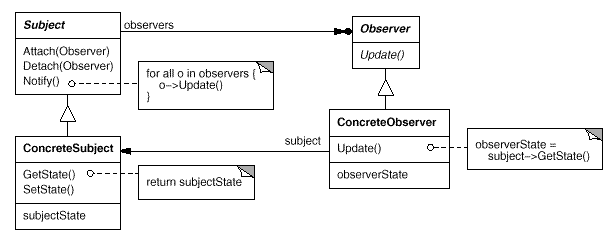Observer
- Intent: Define a one-to-many dependency between objects so that when one object changes state, all its dependents are notified and updated automatically.
- Also known as “Dependents” or “Publish-Subscribe”.
- Use observer pattern when:
- an abstraction has two aspects, one dependent on the other. Encapsulating these aspects in separate objects lets you vary and reuse them independently.
- a change to one object requires changing others, and you don’t know how many objects need to be changed.
- an object should be able to notify other objects without making assumptions about who these objects are. In other words, you don’t want these objects tightly coupled.
General Structure

Example
In my example the participants are represented as following:
- Subject: CovidCaseManager
- ConcreteSubject: CovidCasePublisher
- Observer: Subscriber
- ConcreteObserver: EmailNotificationSubscriber, SmsNotificationSubscriber
Pros/Cons
Pros ❤️
- Abstract coupling between Subject and Observer - Because Subject and Observer aren’t tightly coupled, they can belong to different layers of abstraction in a system. A lower-level subject can communicate and inform a higher-level observer, thereby keeping the system’s layering intact.
- Support for broadcast communication - Unlike an ordinary request, the notification that a subject sends needn’t specify its receiver. The notification is broadcast automatically to all interested objects that subscribed to it.
Cons 💔
- Unexpected updates - Because observers have no knowledge of each other’s presence, they can be blind to the ultimate cost of changing the subject. A seemingly innocuous operation on the subject may cause a cascade of updates to observers and their dependent objects.